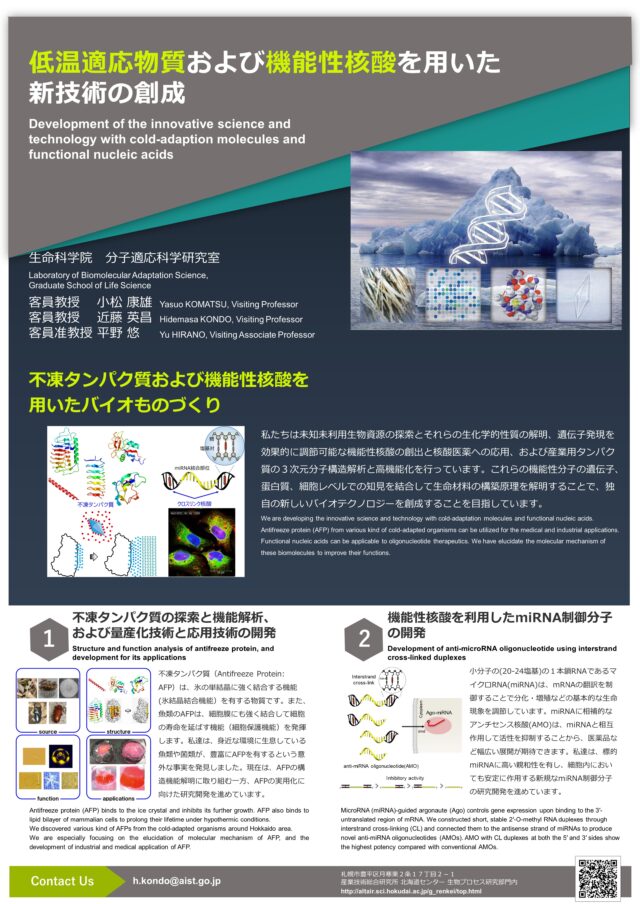Laboratory of Biomolecular Adaptation Science
- Research Theme
- Elucidation of the mechanism and function of adaptation biomolecules for low-temperature environments / Development of novel functional nucleic acids / Development of cell monitoring techniques utilizing scanning electrochemical microscopy
- Research Keywords
Biotechnology, Structural biology, Nucleic acid engineering, Electrochemistry
Molecular structure, Protein, Cell, Antifreeze protein, Functional DNA/RNA, microRNA (miRNA), Regulation of gene expression, Oligonucleotide therapeutics, Scanning electrochemical microscopy, Cell evaluation, Cryobiology, Biosensor
Staff
-
KOMATSU Yasuo Visiting Professor
-
KONDO Hidemasa Visiting Professor
-
HIRANO Yu Visiting Associate Professor
Overview of Research and Education
We explore novel and potentially valuable biological resources and elucidate their biochemical properties. We also develop functional nucleic acids that can efficiently regulate gene expression and apply them to nucleic acid pharmaceuticals. In addition, we are working on developing a cell-monitoring technique by electrochemistry. We are also analyzing 3D structures of industrial proteins. Combining these findings at the gene, protein, and cellular levels, we elucidate principles of molecular adaptations. Also, we are aiming to develop unique new biotechnologies based on these aspects.
Laboratory of Biomolecular Adaptation Science (pdf)
Charge
- Charge (GS):
Graduate School of Life Science, Division of Life Science, Transdisciplinary Life Science Course, (Collaborative Field with AIST) Biomolecular Adaptation Science
Contact
- Address
- 〒062-8517
AIST-Hokkaido, 2-17-2-1 Tsukisamu-Higashi, Toyohira, Sapporo - Phone
- 011-857-8996
- h.kondo*aist.go.jp (Please replace * with @ when sending e-mail.)
Representative Publications
Hirano, Y., and Komatsu, Y., Promotion of cytoplasmic localization of oligonucleotides by connecting cross-linked duplexes. RSC Adv., 12, 24471-24477 (2022).
Okumura, S.; Hirano, Y.; Komatsu, Y. Stable Duplex-Linked Antisense Targeting MiR-148a Inhibits Breast Cancer Cell Proliferation. Sci. Rep. 11 11467 (2021).
Khan, N.M.M.U., Arai, T., Tsuda, S., and Kondo, H., Characterization of microbialantifreeze protein with intermediate activity suggests that a bound-water network is essential for hyperactivity. Scientific Reports 11, 5971 (2021).
Yamauchi, A., Arai, T., Kondo, H., Sasaki, Y.C., and Tsuda, S.: An ice-binding protein from an Antarctic ascomycete is fine-tuned to bind to specific water molecules located in the prosm planes. Biomolecules, 10, 759 (2020).
Arai, T., Fukami, D., Hoshino, T., Kondo, H., and Tsuda, S.: Ice-binding proteins from the fungus Antarctomyces psychrotropicus possibly originate from two different bacteria through horizontal gene transfer. FEBS J., 286, 5, 946-962 (2019).
Mahatabuddin, S., Fukami, D., Arai,T., Nishimiya, Y., Shimizu, R., Shibazaki, C., Kondo, H., Adachi, M., and Tsuda, S.: Polypentagonal ice-like water networks emerge solely in an activity-improved variant of ice-binding protein. Proc. Natl. Acad. Sci. USA,115 (21), 5456-5461 (2018).
